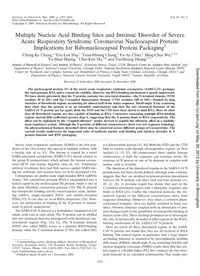
2009 Multiple Nucleic Acid Binding Sites and Intrinsic Disorder of Severe Acute Respiratory Syndrome Coronavirus Nucleoc PDF
Preview 2009 Multiple Nucleic Acid Binding Sites and Intrinsic Disorder of Severe Acute Respiratory Syndrome Coronavirus Nucleoc
JOURNAL OF VIROLOGY, Mar. 2009, p. 2255–2264 Vol. 83, No. 5 0022-538X/09/$08.00�0 doi:10.1128/JVI.02001-08 Copyright © 2009, American Society for Microbiology. All Rights Reserved. Multiple Nucleic Acid Binding Sites and Intrinsic Disorder of Severe Acute Respiratory Syndrome Coronavirus Nucleocapsid Protein: Implications for Ribonucleocapsid Protein Packaging� Chung-Ke Chang,1 Yen-Lan Hsu,1 Yuan-Hsiang Chang,1 Fa-An Chao,1 Ming-Chya Wu,2,3,4 Yu-Shan Huang,5 Chin-Kun Hu,3,6 and Tai-Huang Huang1,7* Institute of Biomedical Sciences1 and Institute of Physics,3 Academia Sinica, Taipei 11529, Research Center for Adaptive Data Analysis2 and Department of Physics,4 National Central University, Chungli 32001, National Synchrotron Radiation Research Center, Hsinchu 30076,5 Center for Nonlinear and Complex Systems and Department of Physics, Chung Yuan Christian University, Chungli 32023,6 and Department of Physics, National Taiwan Normal University, Taipei 10610,7 Taiwan, Republic of China Received 23 September 2008/Accepted 24 November 2008 The nucleocapsid protein (N) of the severe acute respiratory syndrome coronavirus (SARS-CoV) packages the viral genomic RNA and is crucial for viability. However, the RNA-binding mechanism is poorly understood. We have shown previously that the N protein contains two structural domains—the N-terminal domain (NTD; residues 45 to 181) and the C-terminal dimerization domain (CTD; residues 248 to 365)—flanked by long stretches of disordered regions accounting for almost half of the entire sequence. Small-angle X-ray scattering data show that the protein is in an extended conformation and that the two structural domains of the SARS-CoV N protein are far apart. Both the NTD and the CTD have been shown to bind RNA. Here we show that all disordered regions are also capable of binding to RNA. Constructs containing multiple RNA-binding regions showed Hill coefficients greater than 1, suggesting that the N protein binds to RNA cooperatively. The effect can be explained by the “coupled-allostery” model, devised to explain the allosteric effect in a multido- main regulatory system. Although the N proteins of different coronaviruses share very low sequence homology, the physicochemical features described above may be conserved across different groups of Coronaviridae. The current results underscore the important roles of multisite nucleic acid binding and intrinsic disorder in N protein function and RNP packaging. Severe acute respiratory syndrome (SARS) is the first pan- demic of the 21st century that spread to multiple nations, with a fatality rate of ca. 8%. The disease is caused by a novel SARS-associated coronavirus (SARS-CoV) closely related to the group II coronaviruses, which include the human corona- virus OC43 and murine hepatitis virus (6, 18). Traditional antiviral treatments have had little success against SARS dur- ing the outbreak, and vaccines have yet to be developed (35). Coronaviruses are positive-sense single-stranded RNA (ssRNA) viruses. The coronavirus genomic RNA is encapsidated into a helical capsid by the nucleocapsid (N) protein, which is one of the most abundant coronavirus proteins (19). The N protein has nonspecific binding activity toward nucleic acids, includ- ing ssRNA, single-stranded DNA, and double-stranded DNA (33). It can also act as an RNA chaperone (39). How- ever, the mechanism of binding of the N protein to nucleic acids is poorly understood. The SARS-CoV N protein is a homodimer composed of 422 amino acids (aa) in each chain. The N protein can be divided into two structural domains interspersed with disordered (un- structured) regions (Fig. 1A) (2). The N-terminal domain (NTD; also called RBD) serves as a putative RNA-binding domain, while the C-terminal domain (CTD; also called DD) is a dimerization domain (13, 36). Both the NTD and the CTD bind to nucleic acids through electropositive regions on their surfaces (3, 13, 32). All coronaviruses share similar domain architectures at both the sequence and structure levels. No structure of N protein or any of its domains in complex with nucleic acids is available. The functions of the disordered regions in the SARS-CoV N protein have not been clearly defined, although some evidence suggests that they are involved in protein-protein interactions between the N protein and other viral and host proteins (11, 20, 22, 38). A previous report has shown that part of the C-terminal disordered region with a polylysine sequence also binds to RNA (21). Unlike the structural domains, the dis- ordered regions of the different coronaviruses share little sequence homology. However, they share a common physi- cochemical property: they are highly enriched in basic res- idues. Intrinsic disorder coupled with an abundance of pos- itive charges leads to the possibility of nonspecific binding to nucleic acids (34). These findings prompted us to investigate the role of intrinsically disordered (ID) regions in the RNA- binding mechanism of the SARS-CoV N protein. Here we tested all three disordered regions of the SARS- CoV N protein and found that they are all involved in RNA binding. The central region, in particular, had a large impact on binding behavior as monitored by electrophoretic mobility shift assays (EMSA). Small-angle X-ray scattering (SAXS) and nuclear magnetic resonance (NMR) results show that this cen- tral region is a flexible linker (FL) that connects the two struc- tural domains in an extended conformation. Our results pro- * Corresponding author. Mailing address: Institute of Biomedical Sciences, Academia Sinica, 128 Academy Road, Nankang, Taipei 11529, Taiwan. Phone: 886-2-2652-3036. Fax: 886-2-2788-7641. E- mail:
